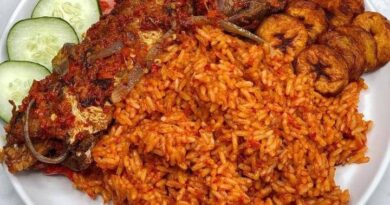African Dish – Achu/Achou
Exploring Achu/Achou: A Culinary Journey into the Heart of African Cuisine
Introduction
Africa is a continent rich in diversity, and its culinary landscape is a testament to the vibrant cultures that call it home. One such culinary gem that often takes center stage in Cameroon is Achu, also known as Achou. This traditional dish is more than just a meal; it’s a cultural experience that reflects the history, heritage, and flavors of the region. In this article, we embark on a delightful journey to uncover the intricacies of Achu, exploring its origins, preparation, and significance in the tapestry of African cuisine.
Origins and Cultural Significance
Achu holds a special place in the culinary traditions of the Western Highlands of Cameroon. It is particularly associated with the North West region and is a favorite among the Bamileke people. This dish is often prepared during festive occasions, weddings, and other significant cultural events, making it a symbol of unity and celebration.
The main components of Achu are cocoyams and yellow soup, accompanied by various side dishes that add depth and variety to the overall dining experience. The dish’s name, Achu, is derived from the grinding process used to prepare the cocoyam, where a mortar and pestle are traditionally employed. This labor-intensive method highlights the commitment to preserving authentic culinary practices.
Ingredients and Preparation
The star of Achu is undoubtedly the cocoyam, a starchy root vegetable with a unique taste and texture. Other key ingredients include yellow soup, which is made from a blend of spices, palm fruit extract, and sometimes, groundnuts. The combination of these elements creates a rich and flavorful base for the dish.
The preparation of Achu is a communal activity, often involving family and community members coming together to share the workload. The cocoyam is peeled, boiled, and then pounded to achieve a smooth, elastic consistency. This laborious process requires patience and skill, as achieving the perfect texture is crucial to the dish’s success.
The yellow soup, on the other hand, involves a meticulous blend of ingredients like crayfish, pepper, utazi leaves, and aromatic eru leaves, which are native to the region. The palm fruit extract adds a distinct color and depth to the soup, making it visually appealing and appetizing.
Accompaniment and Side Dishes
Achu is typically served with an array of side dishes that complement and enhance its flavors. One such accompaniment is “yellow sauce,” a flavorful concoction made from a variety of spices, meat, and vegetables. The choice of meat can vary, with options ranging from goat, chicken, or fish, allowing for personal preferences to shine through.
Plantains and yams are also common additions to the Achu ensemble, providing a delightful contrast in textures and flavors. These side dishes not only add variety to the meal but also showcase the abundance of locally available ingredients.
Cultural Impact and Rituals
Beyond its role as a delectable dish, Achu plays a significant role in cultural rituals and social bonding. The preparation and sharing of Achu often become a communal event, fostering a sense of togetherness and unity among participants. The dish’s consumption during important celebrations reinforces cultural identity and highlights the importance of culinary traditions in preserving a community’s heritage.
Achu is also intertwined with symbolism, with each ingredient representing a cultural or historical aspect. The cocoyam, for instance, signifies strength and resilience, while the yellow soup’s vibrant color represents prosperity and abundance. Understanding these symbolic associations adds depth to the appreciation of Achu as more than just a culinary creation.
Challenges and Preservation Efforts
While Achu remains a cherished dish among the Bamileke people, there are challenges to its preservation and widespread recognition. Modern lifestyles, urbanization, and the availability of convenience foods pose threats to traditional culinary practices. Efforts to sustain and promote Achu involve a combination of cultural education, culinary tourism, and initiatives to make traditional cooking methods more accessible.
Conclusion
Achu/Achou is not just a dish; it’s a cultural masterpiece that encapsulates the spirit and heritage of the Bamileke people in Cameroon. From its labor-intensive preparation to its symbolic significance, Achu tells a story of unity, celebration, and resilience. As we savor the flavors of this traditional African dish, we also appreciate the efforts to preserve and promote culinary traditions, ensuring that future generations can continue to enjoy the rich tapestry of African cuisine.



